Jianxiu Li
Delay-Angle Information Spoofing for Channel State Information-Free Location-Privacy Enhancement
Apr 21, 2025Abstract:In this paper, a delay-angle information spoofing (DAIS) strategy is proposed to enhance the location privacy at the physical layer. More precisely, the location-relevant delays and angles are artificially shifted without the aid of channel state information (CSI) at the transmitter, such that the location perceived by the eavesdropper is incorrect and distinct from the true one. By leveraging the intrinsic structure of the wireless channel, a precoder is designed to achieve DAIS while the legitimate localizer can remove the obfuscation via securely receiving a modest amount of information, i.e., the delay-angle shifts. A lower bound on eavesdropper's localization error is derived, revealing that location privacy is enhanced not only due to estimation error, but also by the geometric mismatch introduced by DAIS. Furthermore, the lower bound is explicitly expressed as a function of the delay-angle shifts, characterizing performance trends and providing the appropriate design of these shift parameters. The statistical hardness of maliciously inferring the delay-angle shifts by a single-antenna eavesdropper as well as the challenges for a multi-antenna eavesdropper are investigated to assess the robustness of the proposed DAIS strategy. Numerical results show that the proposed DAIS strategy results in more than 15 dB performance degradation for the eavesdropper as compared with that for the legitimate localizer at high signal-to-noise ratios, and provides more effective location-privacy enhancement than the prior art.
Optimized Parameter Design for Channel State Information-Free Location Spoofing
Feb 01, 2024

Abstract:In this paper, an augmented analysis of a delay-angle information spoofing (DAIS) is provided for location-privacy preservation, where the location-relevant delays and angles are artificially shifted to obfuscate the eavesdropper with an incorrect physical location. A simplified mismatched Cramer-Rao bound (MCRB) is derived, which clearly manifests that not only estimation error, but also the geometric mismatch introduced by DAIS can lead to a significant increase in localization error for an eavesdropper. Given an assumption of the orthogonality among wireless paths, the simplified MCRB can be further expressed as a function of delay-angle shifts in a closed-form, which enables the more straightforward optimization of these design parameters for location-privacy enhancement. Numerical results are provided, validating the theoretical analysis and showing that the root-mean-square error for eavesdropper's localization can be more than 150 m with the optimized delay-angle shifts for DAIS.
Channel State Information-Free Location-Privacy Enhancement: Delay-Angle Information Spoofing
Oct 23, 2023


Abstract:In this paper, a delay-angle information spoofing (DAIS) strategy is proposed for location-privacy enhancement. By shifting the location-relevant delays and angles without the aid of channel state information (CSI) at the transmitter, the eavesdropper is obfuscated by a physical location that is distinct from the true one. A precoder is designed to preserve location-privacy while the legitimate localizer can remove the obfuscation with the securely shared information. Then, a lower bound on the localization error is derived via the analysis of the geometric mismatch caused by DAIS, validating the enhanced location-privacy. The statistical hardness for the estimation of the shared information is also investigated to assess the robustness to the potential leakage of the designed precoder structure. Numerical comparisons show that the proposed DAIS scheme results in more than 15 dB performance degradation for the illegitimate localizer at high signal-to-noise ratios, which is comparable to a recently proposed CSI-free location-privacy enhancement strategy and is less sensitive to the precoder structure leakage than the prior approach.
Guaranteed Private Communication with Secret Block Structure
Sep 22, 2023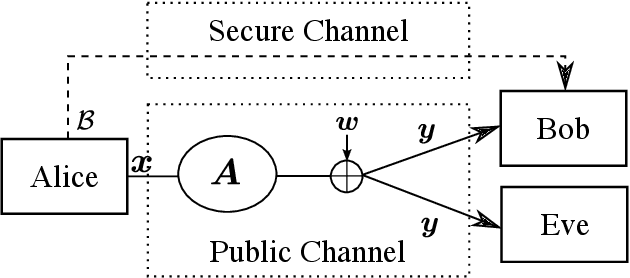
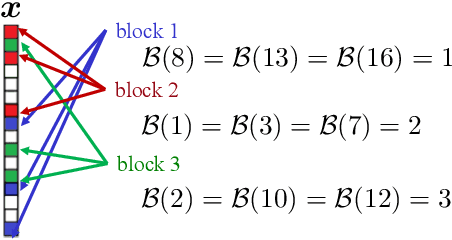
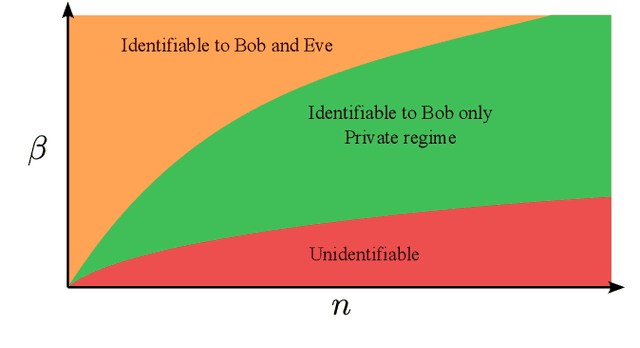
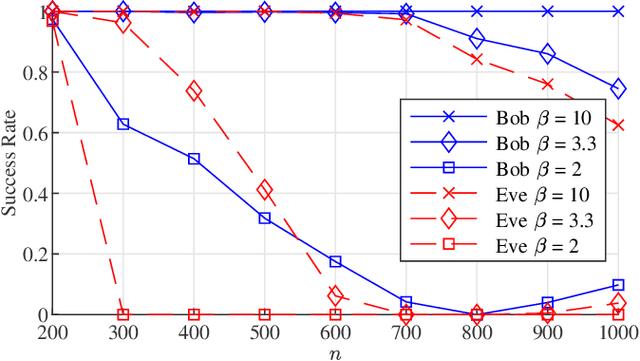
Abstract:A novel private communication framework is proposed where privacy is induced by transmitting over channel instances of linear inverse problems that are identifiable to the legitimate receiver, but unidentifiable to an eavesdropper. The gap in identifiability is created in the framework by leveraging secret knowledge between the transmitter and the legitimate receiver. Specifically, the case where the legitimate receiver harnesses a secret block structure to decode a transmitted block-sparse message from underdetermined linear measurements in conditions where classical compressed sensing would provably fail is examined. The applicability of the proposed scheme to practical multiple access wireless communication systems is discussed. The protocol's privacy is studied under a single transmission, and under multiple transmissions without refreshing the secret block structure. It is shown that, under a specific scaling of the channel dimensions and transmission parameters, the eavesdropper can attempt to overhear the block structure from the fourth-order moments of the channel output. Computation of a statistical lower bound, suggests that the proposed fourth-order moment secret block estimation strategy is near optimal. The performance of a spectral clustering algorithm is studied to that end, defining scaling laws on the lifespan of the secret key before the communication is compromised. Finally, numerical experiments corroborating the theoretical findings are conducted.
Channel State Information-Free Location-Privacy Enhancement: Fake Path Injection
Jul 11, 2023



Abstract:In this paper, a channel state information-free, fake path injection (FPI) scheme is proposed for location-privacy preservation. Specifically, structured artificial noise is designed to introduce virtual fake paths into the channels of the illegitimate devices. By leveraging the geometrical feasibility of the fake paths, under mild conditions, it can be proved that the illegitimate device cannot distinguish between a fake and true path, thus degrading the illegitimate devices' ability to localize. Two closed-form, lower bounds on the illegitimate devices' estimation error are derived via the analysis of the Fisher information of the location-relevant channel parameters, thus characterizing the enhanced location-privacy. A transmit beamformer is proposed, which efficiently injects the virtual fake paths. The intended device receives the two parameters of the beamformer design over a secure channel in order to enable localization. The impact of leaking the beamformer structure and associated localization leakage are analyzed. Theoretical analyses are verified via simulation. Numerical results show that a 20dB degradation of the illegitimate devices' localization accuracy can be achieved thus validating the efficacy of the proposed FPI versus using unstructured Gaussian noise.
Channel State Information-Free Artificial Noise-Aided Location-Privacy Enhancement
Oct 27, 2022

Abstract:In this paper, an artificial noise-aided strategy is presented for location-privacy preservation. A novel framework for the reduction of location-privacy leakage is introduced, where structured artificial noise is designed to degrade the structure of the illegitimate devices' channel, without the aid of channel state information at the transmitter. Then, based on the location-privacy enhancement framework, a transmit beamformer is proposed to efficiently inject the structured artificial noise. Furthermore, the securely shared information is characterized to enable the legitimate devices to localize accurately. Numerical results show a 9dB degradation of illegitimate devices' localization accuracy is achieved, and validate the efficacy of structured artificial noise versus unstructured Gaussian noise.
Weight-based Channel-model Matrix Framework: a reasonable solution for EEG-based cross-dataset emotion recognition
Sep 13, 2022


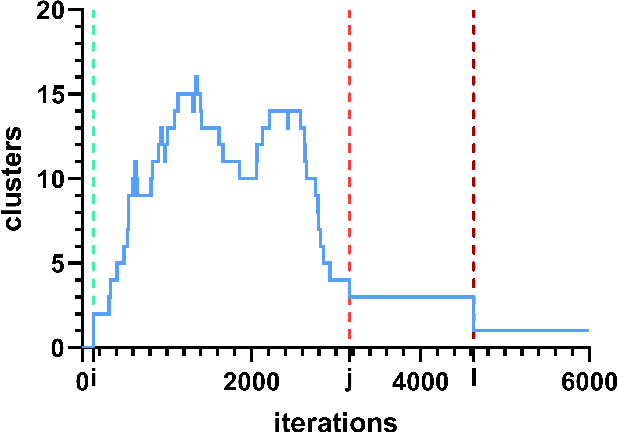
Abstract:Cross-dataset emotion recognition as an extremely challenging task in the field of EEG-based affective computing is influenced by many factors, which make the universal models yield unsatisfactory results. Facing the situation that lack of EEG information decoding researches, we first analyzed the impact of different EEG information(individual, session, emotion, trial) to emotion recognition by sample space visualization, sample aggregation phenomenon quantification, and energy pattern analysis on five public datasets. And based on these phenomena and patterns, we provided the processing methods and interpretable work of various EEG differences. Through the analysis of emotional feature distribution patterns, Individual Emotional Feature Distribution Difference(IEFDD) was found. After analyzing the limitations of traditional modeling approach suffering from IEFDD, we proposed the Weight-based Channel-model Matrix Framework(WCMF). In order to characterize emotional feature distribution patterns reasonably, four weight extraction methods were designed, and the optimal of them is Correction T-test(CT) weight extraction method. Finally, the performance of WCMF was validated on cross-dataset tasks in two kinds of experiments that simulated different practical scenarios, the results showed WCMF had more stable and better emotion recognition ability.
Joint Localization and Orientation Estimation in Millimeter-Wave MIMO OFDM Systems via Atomic Norm Minimization
Mar 02, 2022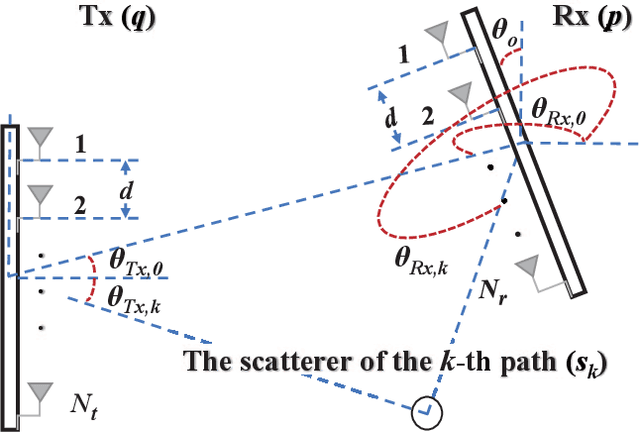



Abstract:Herein, an atomic norm based method for accurately estimating the location and orientation of a target from millimeter-wave multi-input-multi-output (MIMO) orthogonal frequency-division multiplexing (OFDM) signals is presented. A novel virtual channel matrix is introduced and an algorithm to extract localization-relevant channel parameters from its atomic norm decomposition is designed. Then, based on the extended invariance principle, a weighted least squares problem is proposed to accurately recover the location and orientation using both line-of-sight and non-line-of-sight channel information. The conditions for the optimality and uniqueness of the estimate and theoretical guarantees for the estimation error are characterized for the noiseless and the noisy scenarios. Theoretical results are confirmed via simulation. Numerical results investigate the robustness of the proposed algorithm to incorrect model order selection or synchronization error, and highlight performance improvements over a prior method. The resultant performance nearly achieves the Cramer-Rao lower bound on the estimation error.
Atomic Norm Based Localization and Orientation Estimation for Millimeter-Wave MIMO OFDM Systems
Oct 08, 2021
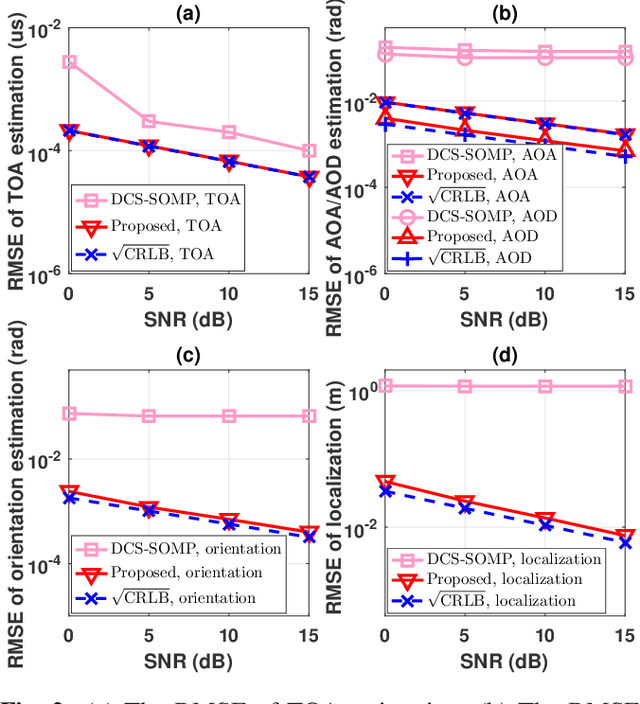
Abstract:Herein, an atomic norm based method for accurately estimating the location and orientation of a target from millimeter-wave multi-input-multi-output (MIMO) orthogonal frequency-division multiplexing (OFDM) signals is presented. A novel virtual channel matrix is introduced and an algorithm to extract localization-relevant channel parameters from its atomic norm decomposition is designed. Then, based on the extended invariance principle, a weighted least squares problem is proposed to accurately recover the location and orientation using both line-of-sight and non-line-of-sight channel information. Numerical results highlight performance improvements over a prior method and the resultant performance nearly achieves the Cramer-Rao lower bound.
MODMA dataset: a Multi-modal Open Dataset for Mental-disorder Analysis
Mar 05, 2020



Abstract:According to the World Health Organization, the number of mental disorder patients, especially depression patients, has grown rapidly and become a leading contributor to the global burden of disease. However, the present common practice of depression diagnosis is based on interviews and clinical scales carried out by doctors, which is not only labor-consuming but also time-consuming. One important reason is due to the lack of physiological indicators for mental disorders. With the rising of tools such as data mining and artificial intelligence, using physiological data to explore new possible physiological indicators of mental disorder and creating new applications for mental disorder diagnosis has become a new research hot topic. However, good quality physiological data for mental disorder patients are hard to acquire. We present a multi-modal open dataset for mental-disorder analysis. The dataset includes EEG and audio data from clinically depressed patients and matching normal controls. All our patients were carefully diagnosed and selected by professional psychiatrists in hospitals. The EEG dataset includes not only data collected using traditional 128-electrodes mounted elastic cap, but also a novel wearable 3-electrode EEG collector for pervasive applications. The 128-electrodes EEG signals of 53 subjects were recorded as both in resting state and under stimulation; the 3-electrode EEG signals of 55 subjects were recorded in resting state; the audio data of 52 subjects were recorded during interviewing, reading, and picture description. We encourage other researchers in the field to use it for testing their methods of mental-disorder analysis.
 Add to Chrome
Add to Chrome Add to Firefox
Add to Firefox Add to Edge
Add to Edge